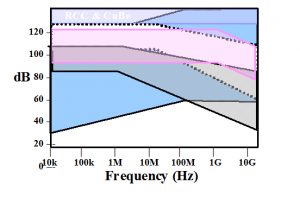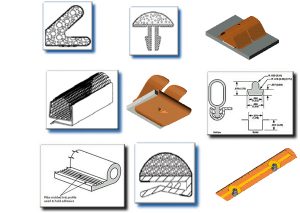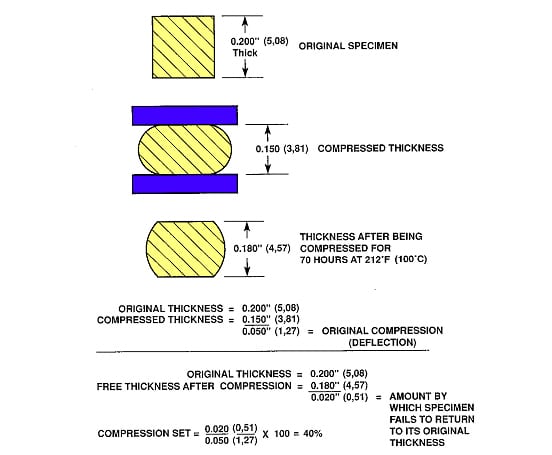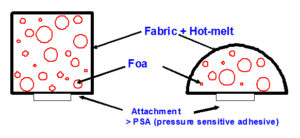Gary Fenical
Laird Technologies
INTRODUCTION
Designers must attenuate RF signals for various reasons. Since a product cannot be legally marketed unless it meets EMC requirements, designers must curtail RF signals above a certain limit. It is important to consider RF shielding materials at the beginning of a design project because choosing the correct kind of shielding upfront assures that an electronic device will achieve optimum functionality. It also assures that any EMI issue can be found and resolved early in the design process, a design strategy that saves both time and money. Such forethought also speeds the latest products to market and to profitability.
Filtering can be very effective in many instances, but can have an impact on signal integrity. In contrast, shielding materials achieve suppression, but have no effect on the wave shape or the intended operation of the signal path. Because the shielding material is not inserted into the circuit, it has no affect on the high frequency operating speed of the system. Moreover, its effectiveness will not change should alterations be made to the design some time in the future. Shielding does not create timing problems and waveform distortion, nor does it decrease system reliability. It does, however, reduce crosstalk. Plus, shielding offers the added benefit of handling both emission and susceptibility problems. In fact, shielding will increase immunity even if it was installed only for emission suppression. RF gaskets can be used to provide isolation between anything from individual components to entire sections of complete systems.
In today’s sophisticated electronic devices, using just one technique to achieve EMC compliance is neither sufficient nor economical. A complete program of carefully designed layout, filtering, grounding, and shielding is required. In addition to these specific choices, the design team must follow the time-proven basics of sound enclosure design.1The careful designer will try to resolve EMI at the source or receptor. The designer who gives careful consideration to the choice of RF shielding materials is rewarded with a degree of confidence when sending off the ultimate product for compliance testing. Clearly, no one wants to hear that the product that is scheduled for market introduction next week is out of compliance. At component level, efficient isolation is usually achieved using BLS (board level shields).
This article will focus on RF gaskets although some of the considerations explored can apply to board level shields. In fact, designers sometimes turn to combination products such as mold-in-place board level shields using both gasket material and metal to create a very effective and efficient shield. The four basic types of RF gaskets (Figure 1) are:
- Metal, sometimes referred to as fingerstock, includes a large variety of metals, with varying profiles, mounting methods, and other characteristics.
- Electrically conductive elastomer (ECE) refers to dozens of elastomer/filler combinations with many mounting methods and unlimited profiles produced by various manufacturing methods—including extrusion, molding, depositing, die-cutting, form-in-place (FiP), and mold-in-place (MiP).
- Knitted mesh comes in both metal and conductive yarns.
- Fabric-over-foam (FoF) is a conductive fabric wrapped over a non-conductive foam core.

Details on the manufacturing of gaskets and specific and specific features and benefits are readily available from manufacturers and may well arrive along with the purchased gaskets. Still, there are basic considerations that should guide the designer in making the all-important initial choice. These considerations are not in any specific order. The thoughtful designer should evaluate each one and should determine its relevance to a particular application.
OPERATING FREQUENCY
Critical criteria when choosing an RF gasket include an exact determination of the RF frequency involved, harmonics, and distance from the source.
Limiting consideration solely to the RF frequency involved could lead to the choice of an inappropriate gasket. In fact, many gaskets work well across wide frequency ranges, but some may perform better in certain circumstances. Generally metals have shielding effectiveness (SE) values in excess of a 100 dB from 10 kHz to 10 GHz. They maintain consistent SE across the entire frequency range with little variance. The SE of ECE gaskets varies with compression force. Recommended compression values for ECE gaskets are based on SE values up to 120 dB. However, ECE tends to achieve higher SE levels as frequency increases, making it an ideal choice for as operating and data frequencies Knitted mesh gaskets provide excellent SE across a wide frequency range, but that effect tends to decrease at higher frequencies, generally above 10 MHz. This decrease occurs because they are manufactured using knitted wire, a material choice that creates apertures and skin effects. However, SE values remain high from 40 to 90 dB, depending on upon the wire type and the compression.FoF gaskets can be produced with very low compression forces while retaining excellent SE values from 70 to 100 dB up to about one GHz and then falling slightly at a rate of 20 dB per decade of frequency. See Figure 1. Given their overall efficacy, any of these gaskets will provide the required SE for most commercial applications. Consequently, other factors must be considered in making the optimum choice.
ATTENUATION PERFORMANCE
Commonly referred to as shielding effectiveness (SE), attenuation performance is the single, most critical factor in selecting RF shielding materials. Attenuation performance is different in each case. Parameters must be determined before specifying any RF gasket. Also, the attenuation of RF gaskets is impacted by the installation and mounting of the shielding, conductivity of the surrounding materials, and the physical fit of the shielding gasket. In some instances, mechanical factors may require the use of more expensive, high performance material. Conversely, other applications may achieve adequate SE using a lower performance material. Why pay for a top-line material such as beryllium copper when more economical choices provide the necessary shielding?
MATERIALS COMPATIBILITY/CORROSION
It is important to choose a shielding gasket that is compatible with the metal of the conducting surface on which it is to be mounted. RF gaskets are made of metal or materials with metal fillers. With the exception of a few special metals, these metals are not in their natural state. Metals are refined from ore that contains metal oxides. Subsequently, the ore is refined into the metals we use. From the instant that refined metal is created, it begins the process of returning to its natural stable state—i.e., an oxide. This process of reversion can be accelerated by galvanic incompatibility. Galvanic corrosion occurs when two metals are in contact, the two metals are dissimilar, and their junction is in the presence of an electrolyte.
Basic Corrosion Prevention
- Whenever possible, avoid the use of dissimilar metals. The following steps may be taken to prevent, or at least to minimize corrosion potential, in the event that it is necessary to use two dissimilar metals in close contact with one another.
- Limit contact between metals with widely different electrochemical potentials.
- Insert a third metal between the two dissimilar metals, a step that reduces the potential difference of the galvanic couple. For example, nickel or tin-plated copper is suitable is suitable for use with aluminum and silver combinations.
- Design the flange interface so that the surface area of the anodic metal is significantly larger than the cathodic metal. The electromotive force (EMF) difference remains the same; however, the current density is decreased so the corrosive attack on the cathodic metal is reduced.
- Eliminate moisture, salts, and other electrolytes from entering the joint interface with an improved flange design. If this option is not feasible, use an environmental seal outboard of the conductive element in a dual EMI shield/environmental seal.
- Choose the mating pair based on the intended operating environment; then choose an appropriate plating. The appropriate choice will depend on several factors. A clean room or air conditioned office is considered a fairly benign environment, and the designer can choose from a number of plating options. In a slightly harsher environment such as a manufacturing facility, greater care must be given to plating selection. Finally, in an extreme environment where the device will be subjected to wind, rain, snow, or temperature changes, the utmost care must be exercised when plating is selected.
ENVIRONMENTAL SEALING
An electrically conductive elastomer (ECE) is the only product that combines both RF shielding and environmental properties. While the these two characteristics are inherent in an RF ECE, an alternate option is pairing another gasket type with an outboard environment seal. Such a seal will keep any harsh environmental conditions from reaching the metals and the gaskets in the interior of the device.
With its dual characteristic, the ECE gasket is generally the smallest and most efficient product for providing both RF shielding and environmental production. It may not be suitable in every application. If mechanical and space considerations allow, a combination gasket might be considered. Such gaskets are made of metal/elastomer or knitted elastomer, and in some applications they may prove more economical.
COMPRESSION LOAD OR FORCE
As pressure is applied to the shielding gasket, it can change shape resulting in inferior performance. Careful selection must be given to choosing the correct size, thickness, shape, and material.
Properly designed gaskets rarely fail. Failure is usually the result of improper installation or use. Inappropriate use will affect gasket compression. If the gasket is under-compressed, it cannot achieve its advertised SE. If it is over-compressed, it will likely sustain damage that, in turn, results in inferior shielding performance.
Other load and force considerations must be considered. These include the base metal material and thickness, fastener spacing, and the flatness of the mating surface. Today, the available range of gasket materials can handle a wide range of compression forces. For example, some material such as fabric-over-foam and ultra-soft metals can be used with extremely low compression while providing excellent shielding effectiveness.
In ECE materials, density, specific gravity, shore A, and conductive particle loading affect the compression and load forces on the gasket. Quantifying these factors can become quite complicated. Gasket manufacturers that support knowledgeable field application engineers (FAEs) are the best source for sorting through all of these factors and in identifying the appropriate gasket for each application.
For applications in which weight is a factor, lower compression forces allow for lighter weight base materials. Weight is especially important in the aerospace and space craft industries. The automobile industry also strives to limit weight when possible.
With today’s light weight plastic products compression force is a vital consideration. Thin plastic cases cannot withstand the pressure that is required to compress many gaskets. The designer must choose a gasket designed especially to work with a low compression force.

Many types of mountings are available including pressure-sensitive adhesive (PSA), clip-on, slot-mounted, riveted, soldered, welded, fitted die-cut profiles, snap-in, and many more.
Mounting methods are limited only by the designer’s imagination. Figure 2 shows a few more common methods. Remember to take into account any environmental concerns such as humidity or corrosive environments that could affect the mounting method.
Obviously, the different gasket types such as metal, knitted wire mesh, FoF, ECE, or a combination type will determine, or possibly limit, the choice of mounting methods. Again, the prudent designer must have the foresight to plan ahead regarding EMI issues and should create an overall design that will accommodate a suitable mounting for gaskets. Trying to install a gasket into a space where it was never intended to go is an exercise in futility at best; and in the worst scenario becomes a waste of time and money that provides inadequate RF shielding.
DEMANDING/HARSH ENVIRONMENTS
The right choice of gasketing is particularly critical in sectors in which equipment may be subjected to harsh wash-down, chemical, or processing procedures. This consideration is especially significant in military applications, but also holds true in some medical and food service settings. Generally, metals are not a good choice if there is contact with moisture. Elastomers are the best choice for such applications. If metal gaskets are used for the EMI seal, it is advisable to use an outboard elastomer seal to prevent moisture damage. As noted above, whether a combination of metal/elastomer or ECE is chosen will depend upon several factors. In many cases, size will be the determining factor as ECE is the only gasket choice that provides both RF shielding and occlusion of moisture in one compact gasket. Table 1 indicates base elastomers and suitable uses.

COMPRESSION
Compression force, compression range, and compression set must be considered to achieve effective performance and to extend the “longevity” of the gasket.
Compression Range
Solid metal gaskets, especially copper beryllium (CuBe), have a maximum deflection range of approximately 90 percent of their free height. Other metal gaskets have varying ranges; the range for recyclable clean copper (RCC) comes close to that of CuBe. In comparison, the usable range for hollow core CuBe wire mesh is 75 percent; for “solid” wire mesh, it’s 10 percent; and for “solid” elastomers, it’s 15 percent.
Geometry is not such an important issue for metal finger gaskets, but it is very important for wire mesh and conductive elastomers. For example, depending upon the shape, conductive elastomers deflection ranges from 15 percent up to about 60 percent—the usable range is approximately half of this value. The elastomer shape regarded as the best trade-off between compression force and compression height is a hollow tube (either circular or with a “D” cross section). With this configuration, 30- to 40-percent usable deflection can be achieved. FoF gaskets have a wide range of workable compression heights, determined largely by the foam core and the geometry of the gasket.
Compression Force/Compression Set
Depending upon the configuration, CuBe, RCC (recyclable clean copper) solid metal, and CuBe hollow core wire mesh gaskets typically require compression forces between three to 20 pounds per linear foot to establish surface contact and to provide adequate shielding. Monel or tin-plated, copper-clad steel (SnCuFe) wire mesh and elastomer gaskets require compression forces of up to 800 pounds per linear foot to achieve maximum shielding effectiveness. A combination of compression force and gasket material characteristics determines the compression set.
Compression set requires the user to increasingly higher compression forces to the gasket after each opening of the enclosure to maintain a constant shielding effectiveness value. An additional degree of compression set takes place during each repeated opening/closing cycle. This cumulative process is demonstrated in Figure 3. This compression set cycle continues until the gasket loses its resiliency; and at that point, it must be replaced.

Depending upon the manufacturing method used, RCC and CuBe spring fingers and CuBe wire mesh gaskets have no compression set. This marked resiliency is characteristic of the alloys and is a function of the way in which the alloy material was processed, rather than configuration. Conductive elastomer and FoF gaskets, particularly in the taller configurations, have compression set values in excess of 25 to 35 percent. For Monel and SnCuFe wire mesh, compression set is about half that of the conducted elastomer and runs about 10 to 15 percent. Solid metal gaskets made from cold-worked spring materials, such as stainless steel and phosphor bronze, have compression sets of about half of the corresponding wire mesh value and run about four to six percent.
SPACE/WEIGHT CONSIDERATIONS
Unless the design is a space craft, the weight of the gasket material chosen is usually not an issue. Most terrestrial applications are not concerned with weight savings of a few ounces achieved using a particular gasket design. Comparing the different gasket designs, the RCC and CuBe solid metal or hollow core wire mesh, as well as FoF gaskets, tend to be lighter in weight. In fact, they are usually one-sixth the weight of Monel/SnCuFn wire mesh or conductive elastomers. Also, the use of metal gaskets allows the designer to reduce the weight of the overall system configuration. The lower mechanical forces required by RCC and CuBe gaskets allow the use of lighter weight structural materials. This overall weight reduction is also true for FoF and new compressible compounds used for mold-in-place and form-in-place gasketing. See the examples in Figure 4. This factor is usually more important than the actual weight of the gasket not only in avionic applications, but also in applications such as metal or plastic miniature handheld devices where lower fastener withdrawal forces are recommended.

RECYCLABILITY
Products must meet the current RoHS requirements of the European Union as well as environmental requirements imposed by manufacturers.
Every year, there’s more and more evidence that our world is a fragile place. This fragility demands that new environmental laws and regulations be put into place to preserve resources and to protect humans and their surroundings. Electrical and electronic equipment have been singled out as potential environmental hazards; and consequently, the European Community and its constituent states have adoped RoHS and WEEE. RoHS, or the “Restriction of the Use of Certain Hazardous Substances in Electrical and Electronic Equipment (Directive 2002/95/EC)” and WEEE or “Waste Electrical and Electronic Equipment (Directive 2002/96/EC)” are two European directives restricting the use of certain substances and dictating the way in which materials are to be discarded or recycled.
Many of the new laws and regulations, such as RoHS and WEEE, have forced companies to look for alternative solutions for products destined for the European market. Electronic manufacturers have expanded their research efforts to seek out cost-effective, safe, environmentally responsible alternate solutions to use in otherwise successful products. The RoHS directive states that new electrical and electronic equipment may not contain certain environmentally harmful materials such as lead and mercury. Beryllium is not listed as a restricted material but is on the “watch list” and may be restricted in the near future. Although all beryllium copper RF gaskets are exempt from the directives for the time being, many OEM customers are seeking a beryllium-free solution. The scope of future industry directives and legislation are uncertain, but the trend toward a “greener” marketplace is clear. Customer demands and a growing recognition of the importance of environmental stewardship have created a clear mandate to develop alternate alloys. Ironically, the rising price of beryllium in the new “greener” marketplace has only added to the impetus to find a new alloy for shielding alloy for RF gasketing.

The final result of extensive research was the development of the recyclable clean copper (RCC), one of the metal gaskets discussed above and included in Figure 1. These gaskets offer a new range of environmentally friendly, copper-based shielding options. These new products provide a beryllium-free EMI solution for use in a wide range of slotted applications. RCC is fully compliant to the RoHS Directive and alleviates the environmental, safety, and segregation concerns associated with the traditional use of beryllium-based copper alloys. This new gasket is characterized excellent mechanical properties. It displays superior yield strength (over 1000 MPa) compared to other copper alloys. It exhibits excellent elastic resilience and offers comparable spring performance to that of CuBe.
Green FoF
Another gasket alternative is a halogen-free product compliant with IEC 61249-2-21:2003. This type of gasket provides shielding effectiveness in excess of 100 dB to 1 GHz. It has an extremely low compression force ranging from 5 to 10 lb/ft and low surface resistivity. Its operating temperature ranges from -40 degrees to +150 degrees F, and its flame classification is UL 94 VO. It contains neither BFRs (bromated flame retardants) nor halogen in either the foam core or the pressure sensitive adhesive. See Figure 5 and Table 2.

CONCLUSION
This article reviewed the basic types of RF gaskets and ten vital factors to be reviewed in using gaskets in shielded enclosure design. It should be noted that while these topics are important, an effective EMC Design Plan will also factor in other vital considerations including cost, life cycle, applicable standards, storage environment, shielding and grounding, electrical requirements, and product safety.
REFERENCES
[1] G. Fenical, “Cost Considerations for Selecting RF Shielding Materials.” Interference Technology Test and Design Guide, pp. 70–78, October 2007.
ABOUT THE AUTHOR
Gary Fenical is the Senior EMC Engineer at Laird Technologies and is the author of many articles on EMC requirements for medical devices, Mutual Recognition Agreements, and guidelines to meet the essential requirements of the EMC Directive. Gary is currently chairman of the SAE AE-4, E3 Committee on EMC. Gary can be reached at (570) 424-8510, [email protected].
